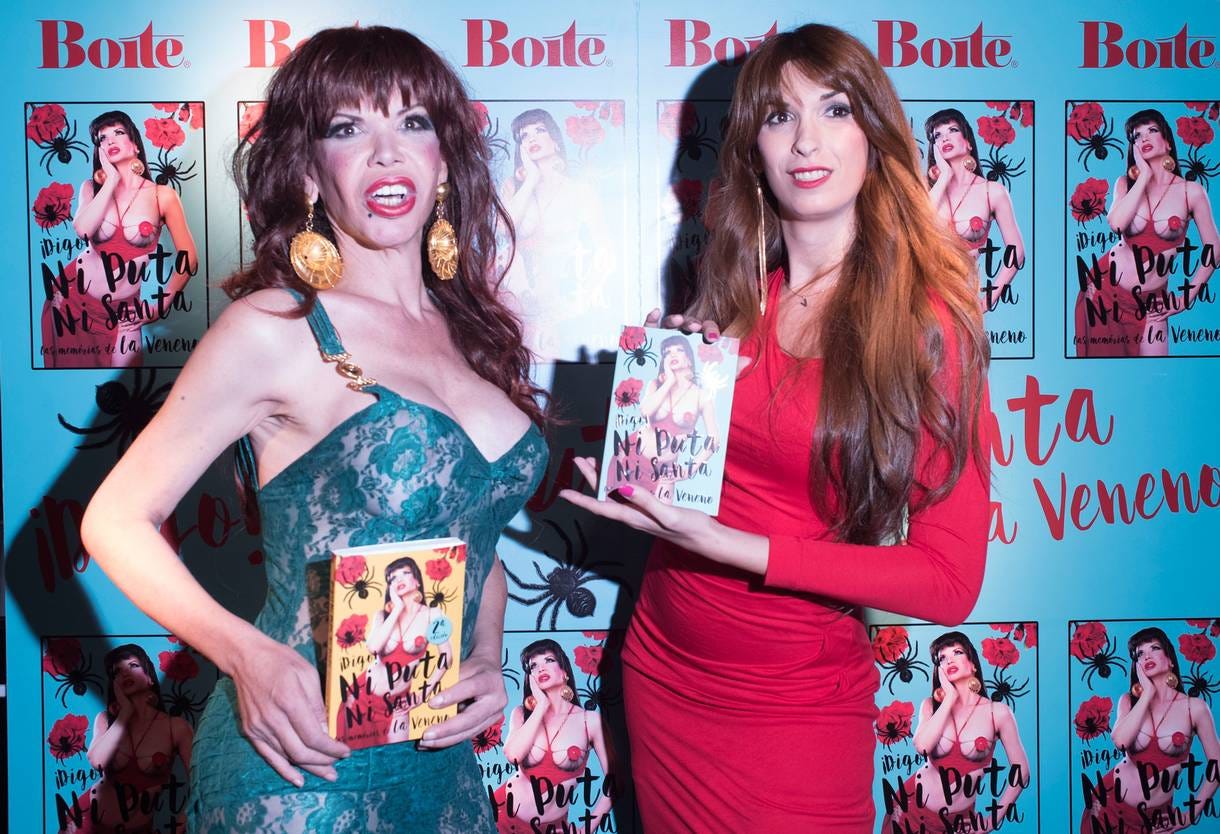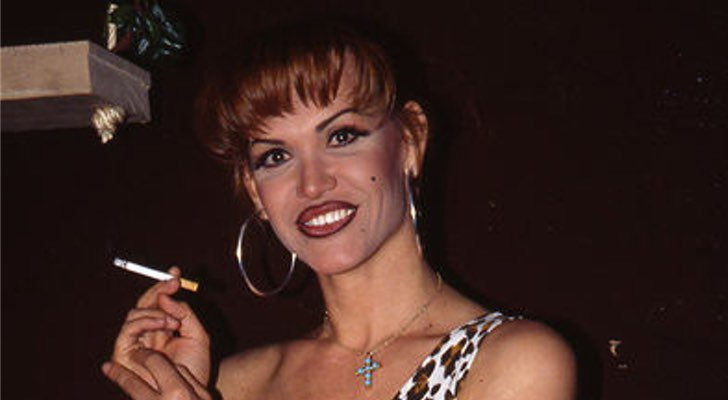If there’s any single individual who defies both categorization and polite conversation, it is Cristina Ortiz, better known as La Veneno. Spain may be known for its flamenco and its bullfights, but nothing quite prepares you for La Veneno. She wasn’t just a media sensation or a “figure of scandal” in the ’90s; she was a human Molotov cocktail of wit, beauty, and pure unfiltered chaos tossed right into the living rooms of a very unsuspecting Spain.
Born in the rural depths of Adra, a small fishing town that could not have been further from the spectacle of Madrid, La Veneno began her life as José Antonio. She grew up in a world that seemed designed to stifle every bit of flair she had to offer, and flair she had. But her trajectory—if you can call it that—was anything but predictable. She escaped the restrictive silence of Adra, not just running but hurtling towards a destiny uniquely her own, eventually becoming the fiery, larger-than-life Veneno who captured both the hearts and moral outrage of Spain. Her story is one of defiance, self-realization, and unapologetic greatness.
Now, in a sense, La Veneno did for the Spanish tabloid scene what Picasso did for modern art: she reinvented it, but with way more sequins. When she first appeared on Esta Noche Cruzamos el Mississippi, she had the audience transfixed, if not scandalized. This was not just a talk show appearance; this was a full-on cultural event. Here was a transgender woman, unapologetically candid, boasting about her exploits and cracking jokes that could probably singe the eyelashes off a bull. She talked about her life as a sex worker, her many lovers, and her scandalous adventures with the same casual enthusiasm most people reserve for discussing the weather. In her own words, she was la "más guapa, la más divina, y la más mala"—the most beautiful, the most divine, and, of course, the baddest of them all. And let’s be real, it wasn’t even an exaggeration.
Her arrival on national television was a subversion of traditional Spanish norms. The media, ever hungry for scandal, quickly latched onto her, but there was something more to La Veneno than just the wild persona she presented to the world. Beneath the sequins and charisma was a woman who had lived a life of unimaginable hardship, whose beauty and sharp humor masked years of systemic exclusion, violence, and heartbreak. La Veneno wasn’t just defying gender norms; she was confronting the very structures of power that had made her life a battleground.
But the glitz of La Veneno’s public life barely scratched the surface of the hardship behind it. Like many transgender women of her era, Cristina lived a life marked by systemic exclusion and danger. Her early years in Madrid were spent on the streets, surviving as a sex worker—a job that, for many like her, wasn’t exactly a choice but a last resort in a society that seemed determined to keep her on the margins. She lived boldly, but it wasn’t without consequence. She faced violence, arrests, and public humiliation with a resilience that bordered on the superhuman. She would recount these ordeals with a wry smile, masking the very real danger she navigated daily in a world that still struggles to respect or protect people like her.
Her rise to fame was, in many ways, an accident of fate—a collision between the crushing reality of her early life and the explosion of visibility that came with her appearance on television. But fame, as La Veneno would soon learn, was a double-edged sword. The media that once adored her quickly turned on her, and the once-celebrated icon found herself abandoned by those who had helped to create her image. Fame, it turned out, was a fickle lover, one that could turn its back as easily as it had embraced her.
Her time in prison was one of the darkest chapters of her life. Sentenced for a minor fraud conviction, she found herself placed in a men’s prison, a situation as brutal as it was cruelly ironic for someone who’d fought so hard to be recognized as a woman. Incarceration nearly destroyed her, both physically and emotionally. Her health deteriorated, and the isolation seemed to rob her of that infamous Veneno fire. Yet even from behind bars, she remained unapologetic, as if daring the world to take her down entirely. She emerged diminished, perhaps, but not defeated, ready to remind Spain that La Veneno didn’t fade quietly into the background.
But Cristina Ortiz was far from done. Just when it seemed her story might slip into obscurity, Valeria Vegas, a journalist with a heart that matched La Veneno’s fiery soul, brought it roaring back to life. Vegas captured La Veneno’s story in ¡Digo! Ni Puta Ni Santa: Las Memorias de La Veneno, a biography that didn’t just present La Veneno’s story—it elevated it. Vegas’s narrative peeled back the tabloid caricature, revealing the layers of pain, resilience, and raw humanity beneath. It took the woman who was often reduced to a punchline and restored her dignity, showcasing the determination of someone who had to fight for every moment of joy and every shred of respect.
Then, on the heels of this book, came Veneno, the television series that reintroduced Cristina Ortiz to a new generation. This wasn’t just a biopic; it was a cultural reckoning. Created by Javier Calvo and Javier Ambrossi, Veneno showcased the highs and lows of her life with a compassion that few would have expected in the ‘90s. The series captured her pain and her triumphs, honoring her as a woman who was flawed, heroic, and resilient beyond measure. She became an icon, not of perfection or “model” behavior, but of defiance and self-acceptance, refusing to conform to anyone else’s standards—even in death.
And then came her death, which was as controversial and tragic as the rest of her life. La Veneno was found in her home in Madrid, injured under circumstances that remain shrouded in mystery, leaving questions and conspiracy theories to this day. Many believe she died as she lived: in a maelstrom of misunderstanding, misjudgment, and outright negligence from those around her. She left this world as defiantly as she had lived in it, leaving a cultural legacy far larger than anyone could have expected from a girl out of Adra who just wanted to shine.
Cristina’s life wasn’t all glitter and gags. Beneath her wild persona was a darker narrative of personal hardship, violence, and resilience. Her fame was peppered with betrayal, abandonment, and hardship that would’ve broken anyone less fierce. The media that once adored her eventually abandoned her, and friends often proved unreliable. Yet Cristina’s strength—and perhaps her greatest flaw—was her refusal to ever play the victim. Even when life dragged her down, she came back swinging, always with another one-liner and another outrageous story.
Her life became a battleground for visibility, a constant negotiation between her identity and the world’s understanding of her. And while she was often reduced to a caricature in the media, La Veneno’s true power lay in her ability to remain unapologetically herself, no matter the cost. She defied every box people tried to put her in, creating her own category that was messy, joyful, heartbreaking, and, above all, real.
La Veneno was a product of her time and a force that shattered it. She wasn’t a “perfect” role model, nor did she aspire to be one. Her life was as unpredictable and tragic as it was glamorous and defiant. Perhaps what we love most is that she refused to let the world edit her down. La Veneno lived her truth loudly and colorfully, leaving a legacy that made Spain and the world a little more fabulous—and a lot more daring. Whether she was cracking jokes, speaking truth to power, or simply being herself, La Veneno lived large. And in a world that often demands silence from people like her, that was nothing short of revolutionary.







